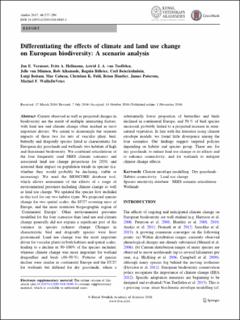Please use this identifier to cite or link to this item:
https://doi.org/10.21256/zhaw-3821| Publication type: | Article in scientific journal |
| Type of review: | Peer review (publication) |
| Title: | Differentiating the effects of climate and land use change on European biodiversity : a scenario analysis |
| Authors: | Vermaat, Jan E. Hellmann, Fritz A. van Teeffelen, Astrid J. A. van Minnen, Jelle Alkemade, Rob Billeter, Regula Beierkuhnlein, Carl Boitani, Luigi Cabeza, Mar Feld, Christian K. Huntley, Brian Paterson, James WallisDeVries, Michiel F. |
| DOI: | 10.21256/zhaw-3821 10.1007/s13280-016-0840-3 |
| Published in: | Ambio |
| Volume(Issue): | 46 |
| Issue: | 3 |
| Page(s): | 277 |
| Pages to: | 290 |
| Issue Date: | Apr-2017 |
| Publisher / Ed. Institution: | Springer |
| ISSN: | 0044-7447 1654-7209 |
| Language: | English |
| Subjects: | Climate envelope modelling; Dry grassland; Habitat connectivity; Land use change; SRES scenario articulation; Species sensitivity database; Wetland; Animal; Bird; Butterfly; Europe; Odonata; Plant; Biodiversity; Climate change; Theoretical model |
| Subject (DDC): | 577: Ecology |
| Abstract: | Current observed as well as projected changes in biodiversity are the result of multiple interacting factors, with land use and climate change often marked as most important drivers. We aimed to disentangle the separate impacts of these two for sets of vascular plant, bird, butterfly and dragonfly species listed as characteristic for European dry grasslands and wetlands, two habitats of high and threatened biodiversity. We combined articulations of the four frequently used SRES climate scenarios and associated land use change projections for 2030, and assessed their impact on population trends in species (i.e. whether they would probably be declining, stable or increasing). We used the BIOSCORE database tool, which allows assessment of the effects of a range of environmental pressures including climate change as well as land use change. We updated the species lists included in this tool for our two habitat types. We projected species change for two spatial scales: the EU27 covering most of Europe, and the more restricted biogeographic region of 'Continental Europe'. Other environmental pressures modelled for the four scenarios than land use and climate change generally did not explain a significant part of the variance in species richness change. Changes in characteristic bird and dragonfly species were least pronounced. Land use change was the most important driver for vascular plants in both habitats and spatial scales, leading to a decline in 50-100% of the species included, whereas climate change was more important for wetland dragonflies and birds (40-50%). Patterns of species decline were similar in continental Europe and the EU27 for wetlands but differed for dry grasslands, where a substantially lower proportion of butterflies and birds declined in continental Europe, and 50% of bird species increased, probably linked to a projected increase in semi-natural vegetation. In line with the literature using climate envelope models, we found little divergence among the four scenarios. Our findings suggest targeted policies depending on habitat and species group. These are, for dry grasslands, to reduce land use change or its effects and to enhance connectivity, and for wetlands to mitigate climate change effects. |
| Further description: | Erworben im Rahmen der Schweizer Nationallizenzen (http://www.nationallizenzen.ch) |
| URI: | https://digitalcollection.zhaw.ch/handle/11475/7543 |
| Fulltext version: | Published version |
| License (according to publishing contract): | Licence according to publishing contract |
| Restricted until: | 2022-05-01 |
| Departement: | Life Sciences and Facility Management |
| Organisational Unit: | Institute of Natural Resource Sciences (IUNR) |
| Appears in collections: | Publikationen Life Sciences und Facility Management |
Files in This Item:
| File | Description | Size | Format | |
|---|---|---|---|---|
| Vermaat2017_Article_DifferentiatingTheEffectsOfCli.pdf | 1.98 MB | Adobe PDF |  View/Open |
Show full item record
Vermaat, J. E., Hellmann, F. A., van Teeffelen, A. J. A., van Minnen, J., Alkemade, R., Billeter, R., Beierkuhnlein, C., Boitani, L., Cabeza, M., Feld, C. K., Huntley, B., Paterson, J., & WallisDeVries, M. F. (2017). Differentiating the effects of climate and land use change on European biodiversity : a scenario analysis. Ambio, 46(3), 277–290. https://doi.org/10.21256/zhaw-3821
Vermaat, J.E. et al. (2017) ‘Differentiating the effects of climate and land use change on European biodiversity : a scenario analysis’, Ambio, 46(3), pp. 277–290. Available at: https://doi.org/10.21256/zhaw-3821.
J. E. Vermaat et al., “Differentiating the effects of climate and land use change on European biodiversity : a scenario analysis,” Ambio, vol. 46, no. 3, pp. 277–290, Apr. 2017, doi: 10.21256/zhaw-3821.
VERMAAT, Jan E., Fritz A. HELLMANN, Astrid J. A. VAN TEEFFELEN, Jelle VAN MINNEN, Rob ALKEMADE, Regula BILLETER, Carl BEIERKUHNLEIN, Luigi BOITANI, Mar CABEZA, Christian K. FELD, Brian HUNTLEY, James PATERSON und Michiel F. WALLISDEVRIES, 2017. Differentiating the effects of climate and land use change on European biodiversity : a scenario analysis. Ambio. April 2017. Bd. 46, Nr. 3, S. 277–290. DOI 10.21256/zhaw-3821
Vermaat, Jan E., Fritz A. Hellmann, Astrid J. A. van Teeffelen, Jelle van Minnen, Rob Alkemade, Regula Billeter, Carl Beierkuhnlein, et al. 2017. “Differentiating the Effects of Climate and Land Use Change on European Biodiversity : A Scenario Analysis.” Ambio 46 (3): 277–90. https://doi.org/10.21256/zhaw-3821.
Vermaat, Jan E., et al. “Differentiating the Effects of Climate and Land Use Change on European Biodiversity : A Scenario Analysis.” Ambio, vol. 46, no. 3, Apr. 2017, pp. 277–90, https://doi.org/10.21256/zhaw-3821.
Items in DSpace are protected by copyright, with all rights reserved, unless otherwise indicated.